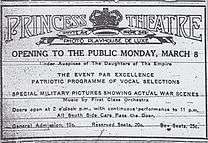Princess Theatre (Edmonton)
 Princess Theatre in 1915, shortly after opening | |
| Address |
10337 Whyte Avenue Edmonton Canada |
|---|---|
| Coordinates | 53°31′04″N 113°29′47″W / 53.5178°N 113.4964°W |
| Designation | Provincial Historic Resource[1] |
| Capacity | Princess: 422; Princess II: 100 |
| Construction | |
| Years active | 1915–1958, 1971–Present |
| Architect | Wilson and Herrald, Edmonton Alberta |
| Website | |
| http://www.princesstheatre.ca | |
The Princess Theatre is a two-screen art-house cinema located at 10337 Whyte Avenue in Edmonton’s historic Old Strathcona neighbourhood. The building was designed by prominent Edmonton architects Wilson and Herrald, a firm responsible for the design of many other Edmonton heritage sites.[2] It became Edmonton's oldest surviving theatre after the demolition of the Gem Theatre in 2006.[3] The building currently houses the main 400-seat theatre as well as the 100-seat Princess II, located in the basement.[4]
It was originally known as the McKernan Block, after John W. McKernan, the building's original financier, owner, and manager.[5] McKernan was already a recognized theatre operator having previously run two other south side theatres before the Princess: the south side Gem and the South Side Bijou. Only the Princess was to survive the collapse of Strathcona’s building boom in 1913.[6]
The building and the theatre within has changed ownership several times, and its fortunes have largely depended on the current state of the Canadian theatre industry. It spent a dozen years as a retail space from 1958–1970,[7] and six years from 1970-1976 mainly exhibiting mainstream pornographic films.[8] The Princess was operated successfully as a repertory theatre from 1978 to late 1996,[8] after which it became a first run theatre.[9] Until 2016, the Princess was operated as a first run theatre by Edmonton’s native Magic Lantern Theatres.[9] From January 2016 the Cinema is being operated by Plaza Entertainment.
Silent era
Early years under J.W. McKernan
The Princess Block, was designed by Edmonton architects Wilson and Herrald, who also designed Whyte Avenue’s Douglas Block, the Strathcona Fire Hall, the Strathcona Public Library, and the University of Alberta’s Rutherford House. From the beginning, the building was designed to combine commercial and residential space, and featured a full basement, small multi-use second floor apartments, and a full third floor in addition to the theatre space.[2]
The building was originally known as the McKernan Block, after John W. McKernan, the Princess’s owner and manager until 1919. The McKernans were a family of property developers in boomtown Strathcona; John’s father developed and ran the historically important Dominion Hotel, also on Whyte Avenue.[5] For his part, J.W. McKernan is considered an important trailblazer in Edmonton entertainment. He opened two other south side theatres before the Princess, the South Side Gem and the South Side Bijou, both of which failed during the collapse of Strathcona's building boom in 1913.[6]
The Princess Theatre opened as a single-screen cinema on March 8, 1915 to rave reviews.[12] It had cost McKernan CDN$75,000 and had taken 10 months to build, longer than expected.[13] The theatre opened with 660 seats and the largest live performance stage in a cinema west of Winnipeg.[13] It was at the time the only cinema on Edmonton’s south side, and would keep that title until the opening of the Garneau Theatre in 1940.[14] Opening night was a benefit concert for The Imperial Order of the Daughters of the Empire, associated with the 19th Alberta Dragoons, B Squad.[13] The program proudly included newsreels “featuring actual war scenes”.[10] In audience were the Lt. Governor and Mayor W.T. Henry.[12] The house’s first feature film, The Eagle’s Mate starring Mary Pickford, was screened the following night.[11]
At the time, the Princess was considered a showpiece of elegance and modernity. It was the first building west of Winnipeg to be faced with marble.[13] The Edmonton Journal remarked on the quality of the “photoplay house’s” finishings, remarking on the solid marble facade, frescoes, brass mirrors and the abundance of gold leaf decoration.[15] On the technical side, two modern projectors[6] were housed in their own fireproof machine room.[15] The Princess was serviced by a freight elevator, which was an unusual feature for a building of its size, and the theatre lighting was indirect and gentle on theatregoers’ eyes.[15] The Journal was also impressed by three novel firsts for a movie theatre in Edmonton: an electric ticketing machine, an “electric time-projecting clock”, and a refrigerated drinking fountain. Perhaps most importantly, the forced air ventilation system was capable of filtering, heating, and cooling air and featured dedicated intake and output fans making the Princess by far the most comfortable theatre in Edmonton.[15]
By 1916, the Princess had stopped booking live acts and was focusing exclusively on the more profitable cinema side of the business.[8] Revenues from the rental spaces in the basement and upper floors had also begun to flow in. Notably, Hugh Morrow, a beat cop, had leased apartment 205.[16] His granddaughter Susan Morrow would manage the Princess from 1981 to 1994.[17]
Wartime proved hard on the film business. On September 23, 1915, Famous Players informed McKernan that “On account of the boat Hesperian having been torpedoed by a German submarine, it will be necessary to skip two Weeklies (short films), these having come forward to ourselves from our London representative via this boat. Regretting this occurrence, and trusting you will appreciate our position on this...”.[18] McKernan’s supply of new films was decreased as the war dragged on,[6] and McKernan advertised less and less frequently.[19] Further complicating things, parts for the theatre’s Edison and Simplex projectors were difficult to come by at the best of times, and the complex machines proved difficult to maintain.[6] McKernan did not live to see business pick up. He contracted Spanish Influenza and pneumonia in rapid succession, and died on February 18, 1919.[18][19]
Alexander Entwisle
The McKernan family leased the theatre to Alexander Entwisle sometime in 1919.[20] Entwisle managed a chain of Edmonton vaudeville houses and cinemas on Jasper Avenue including the Pantages, Empress and Dreamland Theatres.[21]
Around 1919 the basement was first leased to a pool hall, “Dad’s Billiard Room”.[22] While this business was not present in 1920, the basement would house a pool hall continuously from 1927[23] into the 1970s.
Arrival of the sound era
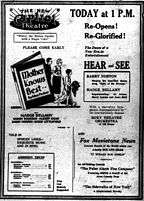
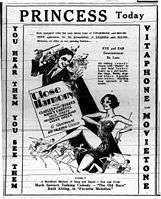

On January 7, 1929, The Capitol Theatre, a major Jasper Avenue competitor to the Princess, closed for renovations promising a change that “will please every theatre-goer in Edmonton”.[27] Almost three months later on March 27, the theatre reopened with dual Movietone and Vitaphone sound systems.[24] The availability of electronically indexed articles from the Edmonton Journal has caused the proliferation of a research error in several local histories. These histories claim that the first talkie screened in Edmonton was The Canary Murder Case, and that it was screened at the Princess.[8][18][28] In fact, the first talkie in Edmonton was Mother Knows Best, screened at the Capitol.[24][26]
The talkies were very well received and hugely successful.[26] The Capitol's business improved greatly in the weeks after re-opening; the size and volume of their advertising in the Journal and Bulletin increased in March, and by April 1929 was several times that of any of their competitors. Other theatres were pressured to modernize their equipment or close.
At the Princess, sound installation was completed by August 16.[29] An entire page of the Edmonton Bulletin was devoted to the reopening,[30] including a congratulating ad from a local record store,[30] an ad for the electrical contractors who installed the wiring,[30] and a message congratulating the Princess placed by the managers of three other establishments already wired for sound: the Rialto, Empress and Capitol Theatres.[31] The physical renovations necessary to accommodate the new wiring were carried out by S. H. Muttart,[29] an important local builder[21] and namesake of the Muttart Conservatory in Edmonton’s River Valley. The first talkie screened at the Princess was Close Harmony starring Buddy Rogers and Nancy Carroll.[25]
Theatre closes
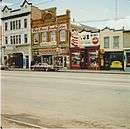

The arrival of television was a disruptive force for Edmonton’s cinemas.[20] The theatre was forced to close in 1958,[33] and the McKernan family sold the Princess Block soon after.[20] The Princess’s last advertisement ran on July 19, 1958 advertising a double bill, Away All Boats and Day of Fury.[32] There were no showtimes, articles or editorials printed in the following days.[34]
The Princess Block disappeared from Henderson’s Directory, a local city directory, in 1956, implying that its researchers thought it was completely vacant.[35] The building was re-included in 1960,[7] but the theatre's former address at 10337 Whyte Avenue remained vacant and unlisted for another six years. By 1966, the exterior doors had been removed entirely to create storefronts (see photo), and the theatre itself had been occupied by Quick Cash Exchange, a pawnshop. The third floor was split into several apartments, while the second floor was entirely occupied by Strathcona TV and Columbia Photo Studio. The basement was still a pool hall, Princess Billiards.[36]
Klondike Theatre
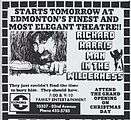
Towne Cinema Limited bought the Princess outright sometime in 1970.[8] The chain owned several theatres in Alberta, including the Towne Cinema on 118 Avenue.[37] The theatre reopened on Christmas Day 1971 as the Klondike Theatre after almost a year of renovations.[34] Towne Cinema restored the original function of the interior of the building, rebuilt sections of the exterior, and installed a new marquee at a cost of $270,000.[28] Its first film was Man in the Wilderness, a family friendly feature starring Richard Harris.[34]
But at some point in 1972, family friendly programming began being interspersed with (and was eventually replaced by) “blue movies”,[8][38][39] such as Swedish Fly Girls.[34] The chain would come to be known for its generally risque material. In 1981, prints of both Caligula and Dracula Sucks were confiscated from multiple Towne locations, and the company was sued by the Government of Alberta under obscenity laws.[40][41]
The Klondike's choice of programming earned it a negative reputation,[38] and Towne Cinema was unable to run the Klondike profitably. The company sought buyers for the theatre as early as 1976, asking $600,000.[8] But, despite all of the theatre's problems under Towne Cinema, it is unlikely that it would have been returned to its original use without the money they poured into its renovation. Their efforts to restore the building are a significant reason why the Princess is a cinema today.
Old Strathcona Foundation
The Old Strathcona Foundation, at that time a publicly funded community development initiative, leased the struggling Klondike in 1977[42] and began searching for ways to use the space. A member of the general public, Frank Grisdale, answered the solicitation, writing a paper outlining how the building could be successfully operated as a repertory theatre under its original name. The foundation was apparently impressed by his proposal, and Grisdale was installed as the Princess Theatre's director upon completion of renovations in 1978.[43]

The theatre was profitable by its second year, and earned the Old Strathcona Foundation $1 million between 1979 and 1989.[8] This was in no small part due to Grisdale's vision of a repertory film house dedicated to championing the independent film genre. During his tenure, Grisdale also introduced live performances, including touring acts such as Sneezy Water's "Hank Williams - The Show He Never Gave". After firmly establishing the Princess as a significant alternative arts establishment in Edmonton, Frank Grisdale resigned and Susan Morrow became the manager in 1981. Morrow expanded the theatre’s program to a glossy monthly magazine.[17] The theatre was offering Saturday morning cartoons,[38] student pricing, and yearly memberships which all contributed to its steadily increasing attendance.[8]
By 1982, the Old Strathcona Foundation was confident enough in the theatre’s prospects to purchase the building outright from Towne Cinema. By this time, the asking price for the building had dropped to $425,000, which was estimated to be $8000 below its real market value.[44] The Foundation began to make major upgrades and repairs to the interior of the building. A fundraising drive in 1987 allowed 422 modern sized plush seats to be installed, lowering the theatre’s original seating capacity by almost 240.[8] In 1989, a soundproofed cry room was installed with an independent sound system, allowing patrons with small children to come to films without worry.[38]
1992 was the theatre’s high-water mark, with a record number of tickets and memberships sold. A state of the art video projection system was installed in June 1993,[45] but in that year revenue declined by $65,000, at least partly because of the growth of home video.[9] The Old Strathcona Foundation began to see the theatre as a liability,[8] and their confidence in the theatre was shaken when Susan Morrow quit her position as manager after having worked at the Princess for fifteen years.[17]
Theatre in crisis
Brian Paisley became the manager in early 1994.[46] Paisley had a history with the Princess; he operated the small, independent Chinook Theatre out of the basement from 1980 to 1983. This organization was the seed of Paisley’s Fringe Theatre Event, which he founded while still working out of this space in 1982. This event was the original Edmonton International Fringe Festival, now the largest event of its kind in North America.[47]
Paisley quickly offered to buy the Princess, and reached an agreement with the Old Strathcona Foundation in October 1994 for an unspecified amount.[48] The banks, however, refused to finance Paisley’s plan and the deal fell through in December.[49] The Old Strathcona Foundation quickly pivoted, and attempted in early 1995 to transfer control of the cinema to the Princess Theatre Society, “a small board made up of film experts and business people” including Paisley.[42]
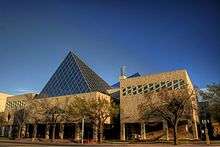
The Princess Theatre Society, while promising, failed to convince the Old Strathcona Foundation that it was capable of profitably managing the theatre, and negotiations broke down in April 1996.[50] Paisley immediately resigned as director and ended his relationship with the theatre two months short of his contract expiring.[50] Malcolm Parker became the new manager.[50]
The Old Strathcona Foundation was running a major deficit by 1996, and in April Edmonton City Council declined to renew a $100,000 annual grant which the Foundation had received since 1985.[51] The Foundation needed cash, and quickly sold the theatre for $450,000 to Calgary’s Brar family, owners of the Plaza Theatre in that city.[52] The decision was not popular, and even Old Strathcona Foundation member Judy Berghofer called the sale hasty.[53]
The entire theatre staff was laid off in December 1996 once it became clear that the Brars were seriously considering purchasing the theatre,[54] and the theatre’s projectionists began what would be a six-month strike when it became clear the Brars would not respect a recently signed two-year contract with the Old Strathcona Foundation.[55]
Edmonton’s native Magic Lantern Theatres unexpectedly tried to buy the Princess for $500,000 on Christmas Eve 1996. A condition in the Brar's contract stated that the sale could be voided if another party bid at least ten percent more for the building.[56] However, the Brars exercised an option to match any higher bids, and the sale went through in early January 1997.[54]
The theatre reputedly fell into disrepair under the Brars. In 1998, the Princess was called “an absolutely lousy advertisement for late 20th century privatization” by Magic Lantern Theatre’s Rick Ostapchuk, who said that the current owners had allowed the theatre to sink “with the velocity, if not the sanitized H20, of a waterslide”.[9] By his count, 170 of the marquee’s 330 lights were burnt out, and he did not believe the interior had been regularly washed or maintained.[9]
Magic Lantern Theatres
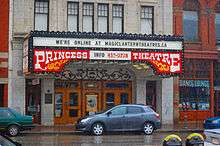
The Brars handed over management of the theatre to Magic Lantern Theatres in June 1998, merely 18 months after purchasing it.[9] Rick Ostapchuk immediately took over double duty as the manager of the recently renovated Garneau Theatre, as well as the Princess.[9]
Ostapchuk vowed to return the Princess to the stature it held under Susan Morrow.[9] To that end, he hired a new film programmer, Leonard Schein of Vancouver’s Fifth Avenue Cinemas. The first film exhibited under new management was Michael Moore’s The Big One.[57] Ostapchuk began major renovations to the theatre, and in 1999 unveiled The Princess II in Chinook Theatre’s old space.[4] The basement theatre featured 100 seats, its own concession and washrooms, and a new 35mm projector. The renovations cost $200,000.[4]
Whyte Avenue multiplex debate
By 1999, Leonard Schein had become president of Alliance Atlantis, and had decided to build a six-screen art house cinema on Whyte Avenue.[58] Many Edmontonians supported the plan, including former Princess manager Malcolm Parker, FAVA Executive Director Helen Folkmann, and Mayor Bill Smith.[58]
Unsurprisingly, Ostapchuk was against Alliance Atlantis’s plans for Whyte Avenue, believing that it would put both the Garneau and the Princess out of business.[59] The Old Strathcona Foundation sided with Magic Lantern, and fought the plans.[60] The argument went all the way to Edmonton City Council, which was asked to waive Old Strathcona’s four-story height limit for the six-story multiplex. Council sided against Alliance Atlantis when Councillor Terry Cavanagh changed his vote at the last minute, defeating the motion 6-5.[61]
Present day
The theatre was operated by Magic Lantern Theatres as a first run cinema until January, 2016. At that point Plaza Entertainment, headed by Mike Brar, took it over again, ending Magic Lantern's tenancy. In 2006, after a lengthy dispute with a local developer, the City of Edmonton demolished the Gem Theatre (constructed 1913) on Jasper Avenue, making the Princess the city’s oldest surviving cinema.[3]
Notes
- ↑ Princess Theatre, Canada's Historic Places.
- 1 2 Herzog (2011).
- 1 2 Demolished theatre (2010).
- 1 2 3 "Underground Cinema" (1999).
- 1 2 Tingley (1999), 269.
- 1 2 3 4 5 Tingley (1999), 265.
- 1 2 Henderson's (1960).
- 1 2 3 4 5 6 7 8 9 10 11 A Theatre With A History (1994).
- 1 2 3 4 5 6 7 8 Kellogg (1998).
- 1 2 "Opening To The Public" (1915).
- 1 2 "Special Announcement" (1915).
- 1 2 "Princess Theatre Royally Opened" (1915).
- 1 2 3 4 Tingley (1999), 263.
- ↑ The Gateway (1940).
- 1 2 3 4 5 6 "Doors of Princess Theatre" (1915).
- ↑ Henderson's (1916).
- 1 2 3 Kellogg (1994).
- 1 2 3 Tasker "Golden Age" (1989).
- 1 2 Tingley (1999), 266.
- 1 2 3 Tingley (1999), 267.
- 1 2 Herzog (2003).
- ↑ Henderson's (1919).
- ↑ Henderson's (1920).
- 1 2 3 "Hear What You See" (1929).
- 1 2 "Princess Today" (1929).
- 1 2 3 "Talkies Are Approved" (1929).
- ↑ "To Capitol Theatre Patrons" (1929).
- 1 2 Herzog (2005).
- 1 2 "Princess Theatre Brings New Movietone" (1929).
- 1 2 3 Edmonton Bulletin (1929).
- ↑ "Congratulations" (1929).
- 1 2 Princess Theatre: All Technicolor (1958).
- ↑ "Historic Theatres in Edmonton" (2006).
- 1 2 3 4 5 Rialto Theatre movie listing ledger.
- ↑ Henderson's (1956).
- ↑ Henderson's (1966).
- ↑ Henderson's (1976).
- 1 2 3 4 Tasker "Grande Dame" (1989).
- ↑ Cernetig (1991).
- ↑ "Court Puts Its Fangs on Dracula Film" (1981).
- ↑ "Today in History" (2001).
- 1 2 Powell (1995).
- ↑ Grisdale (1997).
- ↑ "Council Lets Foundation Buy Princess (1982).
- ↑ Princess Theatre gets new video system (1993).
- ↑ "Paisley new boss at Princess" (1994).
- ↑ "Chinook Theatre" (2008).
- ↑ Horton (1994).
- ↑ Marck (1994).
- 1 2 3 "Princess 'in peril'" (1996).
- ↑ Thomas (1996).
- ↑ Geddes (1996).
- ↑ Thomson (1996).
- 1 2 Barrett (1997).
- ↑ Chattopadhyay (1997).
- ↑ Morningstar (1996).
- ↑ Horton (1998).
- 1 2 Hanes "New art-house" (1999).
- ↑ Hanes "Six-screen" (1999).
- ↑ Retson (2000).
- ↑ O'Donnell (2001).
References
- "A Theatre With a History". Edmonton Journal. November 13, 1994. p. B1.
- Barrett, Tom (January 2, 1997). "Princess Theatre sale confirmed, staff await word". Edmonton Journal. p. B1.
- Cernetig, Miro (August 6, 1991). "City Streets: A celebration of urban life Revolt paved way for rejuvenation". The Globe and Mail. p. A4.
- Chattopadhyay, Piya (May 25, 1997). "Projectionists back at Princess". Edmonton Journal. p. B3.
- "Chinook Theatre / Fringe Theatre Adventures Historical Timeline". Fringe Theatre Adventures, Edmonton. 2008. Retrieved March 18, 2012.
- "Congratulations". Edmonton Bulletin. August 16, 1929. p. 6.
- "Council lets foundation buy Princess Theatre". Edmonton Journal. March 24, 1982. p. G2.
- "Court Puts its Fangs on Dracula Film". Edmonton Journal. February 26, 1981. p. A1.
- "Demolished theatre subject of 2 lawsuits". CBC.ca. CBC News. February 25, 2010. Retrieved March 18, 2012.
- "Doors of New Princess Theatre to be Thrown Open Next Monday". Edmonton Journal. March 6, 1915. p. 15.
- Edmonton Bulletin. August 16, 1929. p. 6. Missing or empty
|title=(help) - "Gateway Sport Section". The Gateway. October 22, 1940. p. 4.
- Geddes, Ashley (December 21, 1996). "Princess Theatre deal announced". Edmonton Journal. pp. B2.
- Grisdale, Frank (January 4, 1997). "New life for the old girl". Edmonton Journal. pp. A9.
- Hanes, Allison (July 29, 1999). "New art-house multiplex pitched for Whyte Ave.". Edmonton Journal. pp. B2.
- Hanes, Allison (July 23, 1999). "Six-screen theatre on Whyte stirs opposition". Edmonton Journal. pp. B3.
- "Hear What You See". Edmonton Bulletin. March 25, 1929. p. 5.
- Henderson's Edmonton Directory 1916. Henderson Directories Alberta, Edmonton. 1916.
- Henderson's Edmonton Directory 1919. Henderson Directories Alberta, Edmonton. 1919.
- Henderson's Edmonton Directory 1920. Henderson Directories Alberta, Edmonton. 1920.
- Henderson's Greater Edmonton Directory 1956. Henderson Directories Limited, Winnipeg. 1956.
- Henderson's Greater Edmonton Directory 1960. Henderson Directories Limited, Winnipeg. 1960.
- Henderson's Edmonton Alberta City Directory 1966. Henderson Directories Limited, Winnipeg. 1966.
- Henderson's Edmonton Alberta City Directory 1976. Henderson Directories Limited, Winnipeg. 1976.
- Herzog, Lawrence (March 3, 2005). "90 Years a Princess". Edmonton Real Estate Weekly. Retrieved March 18, 2012.
- Herzog, Lawrence (March 20, 2003). "Home to a Sheriff, a Builder and a Vaudeville King". Edmonton Real Estate Weekly. Retrieved March 18, 2012.
- Herzog, Lawrence (August 24, 2011). "Strathcona Firehall No. 1". Herzog on Heritage. Edmonton Heritage Council. Retrieved March 18, 2012.
- "Historic Theatres in Edmonton" (PDF). Building Heritage News. The Edmonton Historical Board. November 2007. p. 2. Retrieved March 18, 2012.
- Horton, Marc (October 13, 1994). "Director Brian Paisley buys historic Princess Theatre". Edmonton Journal. p. D1.
- Horton, Marc (June 2, 1998). "Princess under spell of Magic". Edmonton Journal. p. C2.
- Kellogg, Alan (May 28, 1994). "Former Lord Mayor Morrow leaving the city she loves". Edmonton Journal. p. D1.
- Kellogg, Alan (June 6, 1998). "Ostapchuk determined to restore Princess to former lustre". The Edmonton Journal. p. C1 Front.
- Marck, Paul (December 21, 1994). "It's curtains for bid to buy the Princess". Edmonton Journal. p. B1.
- Morningstar, Lasha (December 26, 1996). "Garneau owners bid for Princess". Edmonton Journal. pp. B3.
- O'Donnell, Sarah (May 23, 2001). "Vote switch by Cavanagh sinks Varscona cinema". Edmonton Journal. pp. A1 Front.
- "Opening To The Public Monday, March 8". Edmonton Journal. March 8, 1915. p. 12.
- "Paisley new boss at Princess". Edmonton Journal. March 13, 1994. p. E5.
- Powell, Kerry (March 25, 1995). "Separate group being created to run the Princess". Edmonton Journal. p. B3.
- "Princess 'in peril,' ex-director says". Edmonton Journal. April 11, 1996. p. C4.
- "Princess Theatre". Canada's Historic Places. Parks Canada. Retrieved March 18, 2012.
- "Princess Theatre: All Technicolor Program". Edmonton Journal. July 19, 1958. p. 22.
- "Princess Theatre Brings New Movieone and Vitaphone South Side". Edmonton Bulletin. August 16, 1929. p. 6.
- "Princess Theatre gets new video system". Edmonton Journal. June 30, 1993. p. B12.
- "Princess Theatre Royally Opened". Edmonton Daily Bulletin, Morning Edition. March 9, 1915. p. 3.
- "Princess Theatre Showtimes". Rainbow Cinemas & Magic Lantern Theatres. Retrieved June 6, 2012.
- "Princess Today". Edmonton Bulletin. August 16, 1929. p. 6.
- Retson, Don (January 21, 2000). "Cinema complex delayed". Edmonton Journal. p. B4.
- Rialto Theatre movie listing ledger. Provincial Archives of Alberta, Item Number PR0336. 1936–1972.
- "Special Announcement: Mary Pickford in 'The Eagle's Mate'". Edmonton Journal. March 9, 1915. p. 3.
- "Talkies Are Approved At New Capitol". Edmonton Bulletin. March 28, 1929. p. 13.
- Tasker, Warren (November 19, 1989). "It has taken 70 years for the Princess to reach it's 'Golden Age'". Edmonton Journal. p. D2.
- Tasker, Warren (November 19, 1989). "Strathcona's grande dame; The city's last ornate movie palace is finding long-elusive success". Edmonton Journal. p. D1.
- Thomas, Don (April 24, 1996). "Strathcona Foundation loses city funds". Edmonton Journal. pp. B3.
- Thomson, Graham (December 23, 1996). "Princess' sale too quick, says board member". Edmonton Journal. pp. B3.
- Tingley, Ken (1999). The Best of the Strathcona Plaindealer. Edmonton, Alberta: Pioneer Press Ltd. pp. 263–270. ISBN 0-9694688-1-4.
- "To Capitol Theatre Patrons". Edmonton Bulletin. January 5, 1929. p. 7.
- "Today in History". Edmonton Journal. October 9, 2001. p. E6.
- "Underground cinema for Whyte Ave.; Princess constructs a second screen in basement of its Old Strathcona building; New Theatre". Edmonton Journal. February 27, 1999. p. C4.
External links
- Herzog, Lawrence. "Herzog on Heritage". Edmonton Heritage Council. Retrieved March 19, 2012.
- Herzog, Lawrence. "Edmonton Movie Houses and Theatres". Edmonton Heritage Council and Real Estate Weekly. Retrieved March 18, 2012.
- "Magic Lantern Theatres: Princess Theatre". Retrieved March 19, 2012.
- "Alberta Newspapers Collection". Our Future, Our Past. The Alberta Heritage Digitization Project. Retrieved March 20, 2012.
- "Peel's Prairie Provinces, Newspapers". University of Alberta. Retrieved March 20, 2012.
